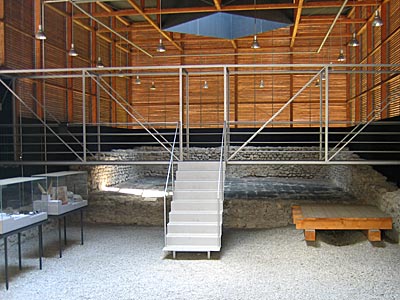Indestructible Romansh survives centuries

A mysterious people, Roman imperialism, German colonisation and the forging of an identity is how Romansh history can best be summed up.
In the first of a series of articles to mark the start on Monday of parliament’s autumn session in Romansh-speaking Flims, swissinfo takes a look at how Switzerland’s fourth – minority – official language has evolved.
The Romans’ legacy to the Mediterranean world was their network of roads and aqueducts. And in much of western Europe, they also left behind their language.
Vulgar Latin, as spoken by Roman soldiers, officials and merchants, merged with other languages of the Roman empire, forming several new variants.
These can be divided into several linguistic groups: Gallo-Romance (French), Occitano-Romance (Occitan, Provençal, Catalan), Ibero-Romance (Spanish, Portuguese, Galician), Italo-Romance (Italian, Corsican) and Balkan Romance (Romanian, Dalmatian).
Dolomitic Ladin and Friulian, used in northern Italy, and Romansh, which is spoken exclusively in Switzerland’s southeastern canton of Graubünden, are known as the Rhaeto-Romance languages.
Mystery
The origins of the Rhaetian people are still unclear, as not much is known about the tribe, which is thought to have arrived in the Alps at around 500 BC.
Experts do not think they were Celtic, but either Etruscans, from the Balkans or Semitic.
The Romans conquered the Rhaetian territory, which stretched between the Rhaetian Alps and the River Danube, in 15 BC.
A regional variant of Vulgar Latin – Romansh – developed. The spread of Christianity from the fourth century onwards also played a part.
In 806 Charlemagne, King of the Franks, introduced the Franconian system of administration into Rhaetia. A German count took over in Chur bringing with him many German-speaking officials and nobles.
Around 40 years later, the Diocese of Chur was detached from the Archdiocese of Milan and became part of the Archdiocese of Mainz, another step towards the northern German-speaking world.
Political autonomy
It was not until the 14th and 15th centuries that the Graubünden area started to gain political autonomy.
The old feudal system was gradually replaced by a more democratic one, based on autonomous communes and high courts. These came together in 1471 to form a loose confederation called the State of the Three Leagues.
The large fire that destroyed the cantonal capital, Chur, in 1464 cemented the region’s linguistic evolution towards German as it was rebuilt by German-speaking artisans.
Meanwhile, from the 16th century onwards Romansh developed into a written language, benefiting notably from the literary drive of the Reformation.
For practical reasons, however, German was the official language of the State of the Three Leagues.
This changed in 1794, when trilingualism in German, Romansh and Italian became official in the State, which in 1803 became the canton of Graubünden.
Although cantonal constitutions of the 19th century continued to support this principle, the authorities still pushed for the Germanisation of Romansh speakers.
Romansh identity
This and an increasingly strong immigration of German speakers into the Romansh heartland, led to calls to save the ancient language.
Lia Rumantscha, the Romansh promotion organisation, was therefore founded in 1919. In 1938 Romansh received another boost when it was recognised as a national language alongside German, French and Italian.
It had to wait until 1996 to became an official language – the status accorded to the other three. It is still only an official language in certain fields.
One of the most significant developments for Romansh in the past few decades was the creation of Rumantsch Grischun, the standard written Romansh, in 1982.
Romansh is actually the term for the five different variants of the language which exist as small islands of Latin across Graubünden.
These idioms are alive – or survive – nonetheless. But Romansh, which is now spoken by just 0.5 per cent of the Swiss population, is still facing many challenges.
swissinfo, Bernard Léchot
The southeastern canton of Graubünden is at 7,105km² the largest Swiss canton.
It has 150 valleys and the two main ones, the Surselva and the Engadine, run parallel to the Alps.
According to the 2000 census, the canton’s population numbers 187,058, of which 127,755 are German speakers, 27,038 Romansh speakers and 19,106 Italian speakers.
This year’s autumn parliamentary session is taking place in Romansh-speaking Flims, in the southeastern canton of Graubünden, from September 18-October 6. It will last three weeks.
As well as an influx of members of the political, economics and cultural sectors, the region of Surselva around Flims is also expecting an increase in visitors.
To mark the event, swissinfo is publishing a series of articles and a dossier on Romansh, delving into the past present and future of Switzerland’s threatened fourth national language.

In compliance with the JTI standards
More: SWI swissinfo.ch certified by the Journalism Trust Initiative
You can find an overview of ongoing debates with our journalists here. Please join us!
If you want to start a conversation about a topic raised in this article or want to report factual errors, email us at english@swissinfo.ch.